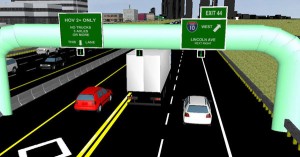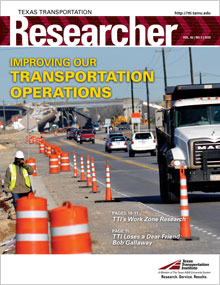
Dress rehearsals are a common element of life. Sports teams typically have walk-throughs, weddings have rehearsal dinners, and plays have dress rehearsals. These are standard practices that don’t change much but are quite valuable. Likewise, transportation agencies and professionals use modeling to simulate how changes to our transportation infrastructure will impact traffic flow.
Where modeling differs greatly from other everyday dress rehearsals is that with technology and innovation, modeling methods can, and do, evolve. During the Texas Department of Transportation’s (TxDOT‘s) Zaragoza/Interstate Highway 10 (I-10) interchange project in El Paso, Texas, Texas Transportation Institute (TTI) Associate Research Scientist Jeff Shelton was charged with providing simulation models for evaluation purposes, but also discovered an innovative modeling method in the process.
While evaluating multiple scenarios for the Zaragoza/I-10 interchange project, Shelton determined that no single modeling method was capable of accurately simulating the scenarios this project presented. Typically, researchers use either a macroscopic, mesoscopic or microscopic model resolution depending on the situations presented by a project, but for this project Shelton found using all the model resolutions together to be advantageous over traditional methods.
“The macro, meso and micro models are not mutually exclusive,” explains Shelton. “They actually complement one another and can accomplish optimal modeling capabilities. By retaining the best characteristics of each model and then integrating them, a more holistic, more complete simulation is possible.”
Multi-resolution modeling (MRM) proved to be that more complete modeling system during the project because it did just what Shelton believed it could do — it provided a more thorough and accurate simulation of the scenarios than any one single model resolution could have done. The most challenging aspect of MRM was retaining consistency between the different resolution models to ensure its accuracy.
“The project team literally spent weeks converting data for MRM during the interchange project, so I knew that MRM would need to become a more time-efficient modeling technique,” says Shelton. “We worked with PTV America and the University of Arizona in developing tools that integrate VISUM, DynusT and VISSIM [various model resolution tools] and make MRM much more time efficient.”
The tools they developed are the VISUM-DynusT Converter (VDC) and the DynusT-VISSIM Converter (DVC). Transportation planners can use the VDC tool to run dynamic traffic assignment (DTA) in their travel demand models and analyze the temporal and spatial distribution of traffic at any given time. Traffic engineers can use the DVC tool by converting over sub-areas from the regional mesoscopic model and converting them to a microscopic model with a high level of fidelity for detailed analyses. With the VDC and DVC tools, MRM actually presents a cost benefit because data that were taking weeks to convert can now be converted in hours.
“It comes as no surprise to me that Jeff has found a way to make a more complete and efficient modeling method because I have seen him use many different techniques on projects to ensure that the quality and accuracy of his work are at the highest level,” says Gus Sanchez, project manager for TxDOT.
